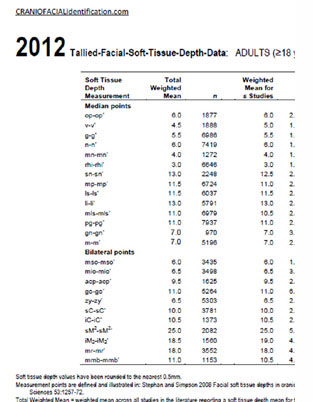The Tallied-Facial-Soft-Tissue-Depth-Data (T-Tables)
 Terms of Use (please read prior to opening or downloading any of the T-Tables)
Terms of Use (please read prior to opening or downloading any of the T-Tables)
The current T-Tables represent a split across years 2013 and 2012.
2013 Adult T-Table available @ The Journal of Forensic Sciences: Stephan CN. (2013) The Application of the Central Limit Theorem and the Law of Large Numbers to Facial Soft Tissue Depths: T-Table Robustness and Trends since 2008. Journal of Forensic Sciences. doi: 10.1111/1556-4029.12328
2012 T-Table: Birth to 11 years
OVERVIEW: The T-tables represent pooled soft tissue depth means from an extensive list of previously published studies. These data are useful for both facial approximation and craniofacial superimposition.
The T-tables offer three sets of soft tissue depth data spread across various stages of the human life cycle: birth to 11 years, 12 to 17 years, and 18 years and beyond. In contrast to seperate studies that typically include fewer than 40 individuals, each of the T-tables report values for more than 3,000 individuals at the more commonly measured craniofacial landmarks.
The T-tables have been generated by collapsing prior data using weighted means and standard deviations within the above mentioned age ranges. This is justified because current uncertainty levels for soft tissue depth measurement (and casework application of data) are large enough to overwhelm the small differences that result from variables such as age, sex, and "race".
In contrast to any single soft tissue depth study, the T-tables holds three prime advantages: i) systematic and random biases specific to each investigation/measurement method are pitched against one another to triangulate upon population parameters; ii) the data are based on very large sample sizes; and iii) small differences, relative to measurement errors, are not used to tenuously sub-categorize the data.
The T-tables are annually updated with data releases made in January of each year. The craniofacial landmarks used and their definitions can be found in the original papers that describe these tables, which were published in vol. 53 of the 2008 series of The Journal of Forensic Sciences (see references below).
Please read the Terms of Use before opening or downloading any of the T-Tables.
